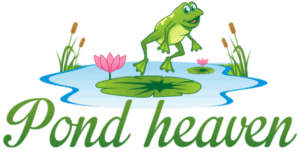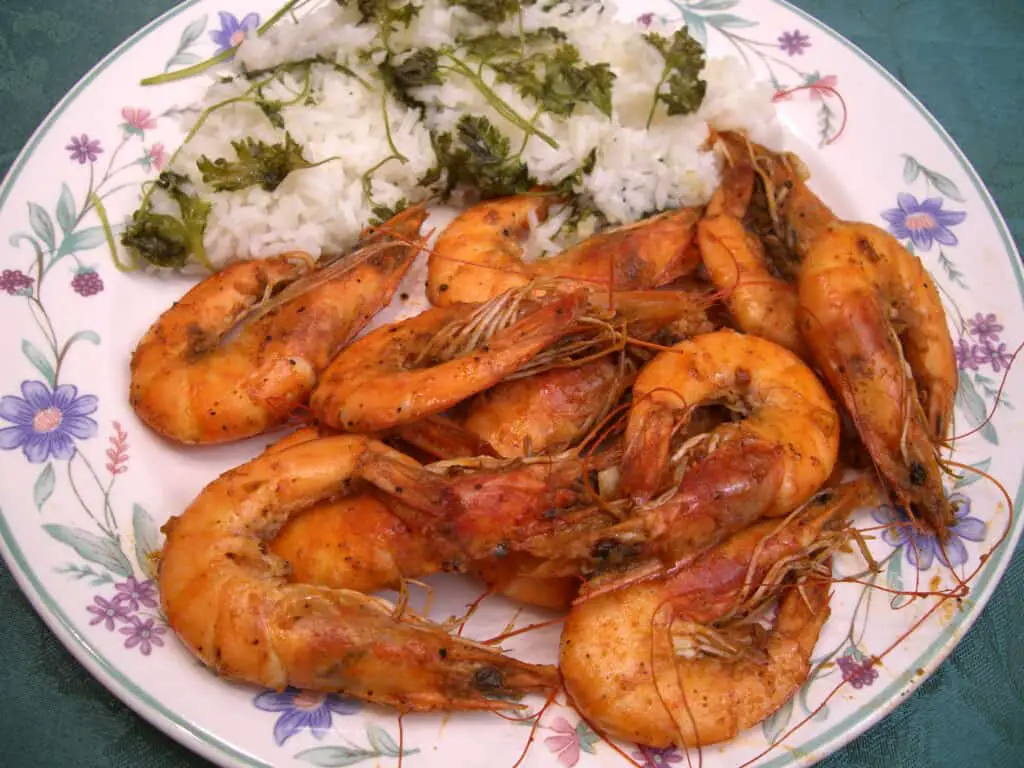
If you have a pond full of beautiful koi fish, you will surely enjoy feeding time. But you may wonder what you can feed them and whether you can make homemade pellets and other fish foods to feed your Koi. So, how do you go about making homemade koi food?
There is often controversy about bought koi foods, and they are expensive. You can save costs, be environmentally conscious, and have greater control over your koi fishes’ nutrition by making pastes or pellets from plant and animal protein sources, healthy fats, and small amounts of carbs.
You may have heard that Koi descend from wild carp, so they would eat a similar diet if they lived in the wild. But how can you replicate the benefits of that diet in the pond in which you have them living? What sorts of foods should you give them, and what balance of ingredients should you put in recipes for homemade foods?
Pro Tip: If you’re tired of wasting money and making costly mistakes on the koi-keeping hobby or are thinking about buying koi fish but don’t know where to start, I strongly suggest you check out this ebook. I recently read this ebook, and it contains SO much useful information, such as:
- 3 proven steps to identify koi fish diseases
- WARNING: 3 things you should NEVER do when it comes to caring for koi
- When to seek professional help when it comes to looking after your koi
What’s The Best Food For Koi Fish?

In the wild, carp (the ancestors of modern Koi) feed on foods such as algae, larvae, plants such as water lettuce and water lilies, aquatic insects, flies, snails, crustaceans, smaller fish, worms, frogs, seeds, and detritus.
They stir these foods up from the bottom of the pond, using their maxillary barbels to tell them where food is or catch them from the water and surrounding habitats at the top of the pond or stream in which they live.
These foods provide the correct nutrients for optimal health, growth, and reproduction. If your koi fish are in an ecosystem pond, they can continue to feed in their natural way, and you will only want to feed them about twice a week, with as much food as the Koi can eat in five minutes.
If you are not keeping them in an ecosystem pond, you will need to feed them once a day for five minutes to ensure they have enough food. You will want to select foods that give them a balanced diet with optimum nutrition.
What you feed them will also depend on the particular season. For example, you should not feed your Koi during winter when they are hibernating, and you should provide them more protein during summer heat when they attain maximum growth rates.
You should only give it for one month when supplementing with spirulina as a color enhancer. It is common to provide it in July or August, the prime months for growth, but you can provide it at any time of the year when the water temperature exceeds 50 degrees Fahrenheit.
The Ideal Nutritional Balance For Koi Diet
Koi need plenty of protein in their diet, and you should shoot for at least 32 to 36 percent protein, although higher protein is not harmful to your fish. Give younger fish around 5 percent more protein to help them to grow.
However, bear in mind that although koi fish can digest both plant and animal proteins, you should provide animal snacks such as blood worms, shrimps, and silkworm larvae in small quantities as treats rather than as staple foods.
It is best to provide most of your koi fish’s protein intake from vegetables or plant foods high in proteins, such as soybeans and chickpeas.
Although delicious and much appreciated by your Koi, feed silkworm larvae sparingly because too many causes a diabetes-like condition in koi fish.
Healthy fat is also essential in your koi fishes’ diet, particularly for younger fish, to help them grow. Between 3 and 9 percent of their diet should be fat, although you can tweak this amount depending on the age and health of your fish. Older fish do not require as much fat unless they are sick.
Ensure that the fat in your fish’s diet comes from healthy sources such as fish oil and linseed oil, not greasy snacks. Linseed oil is perfect for koi fish as it contains linolenic and linoleic acid, the two fatty acids essential for Koi.
Ensure that your Koi get some vitamin E to metabolize the fat adequately. If they do not get enough of this vitamin, they can develop pansteatitis, a fatal disease.
Keep the carbohydrate content of your homemade koi food on the low side: Koi do not need so much carbohydrate. Too much will make your koi fat (tadpole-shaped) without giving them the nutrition they need and cause liver degeneration. Keep the carbohydrate content below 10 percent to prevent this from happening.
However, the precise balance of nutrients that koi fish require depends on the temperature of the water. In the warmer months, when the water is above 60 degrees Fahrenheit, they will need more protein-rich foods for growth and reproduction.
As temperatures fall, you should decrease their protein and give them more carbohydrates from fruit and vegetables to provide quick-release energy in cooler temperatures.
If you supplement their diet with bread, avoid white bread, as the bleaching agents harm koi. Also, avoid corn, peas, and beans, as they cannot digest the hard coating. Mushed-up cooked peas are OK and will give your Koi valuable nutrients.
Keep the phosphorus content of your homemade fish food low, as too much phosphorus, will promote the growth of algae and reduce your water quality.
Ensure that your fish get enough calcium and vitamins A, C, D, E, and K. You can mix in high-quality protein from insect and marine sources and include other foods such as garlic in their diet (in moderation).
Your koi fish also require iron, copper, and magnesium, which they can only obtain from their food (they can obtain other minerals by osmosis from the pond water).
The Four Top Foods For Koi
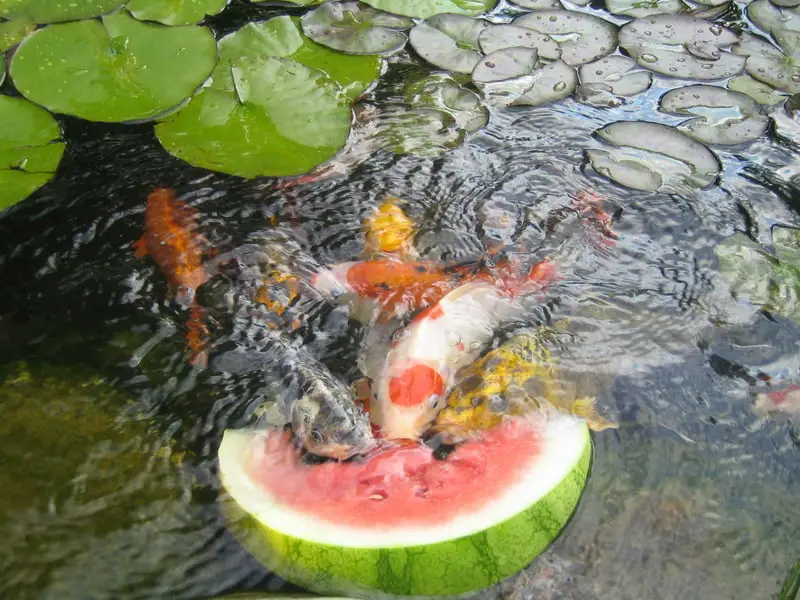
The four top foods for your Koi are spirulina, wheat germ, brine shrimp/krill, and plant foods (fruit and vegetables).
Spirulina, which are cyanobacteria or blue-green algae, live in very hard water with a high pH and photosynthesize. They are incredibly nutritionally dense and provide the following benefits to Koi:
- Promotes faster growth
- Boosted immune systems (preventing disease and parasites)
- Improved digestion
- Promote production of lipid-digesting enzymes (enhances fishes’ ability to use fats for energy)
- Prevents swollen abdomens
- Carotene pigments in the spirulina help bring out the colors of the koi fish
Wheat germ, which is the part of the wheat seed that will sprout to become a new plant, offers the following benefits to Koi:
- Promotes faster growth
- Improves blood circulation
- Promotes balanced growth
- Enhances immune system functioning
Brine shrimp and krill are small crustaceans that live by filter-feeding, concentrating nutrients from the water in their bodies. They pass these nutrients, including high-quality protein, onto your Koi. They are especially valuable for feeding baby koi (fry).
Fruit and vegetables such as broccoli, peas, carrots, citrus fruits, squash, broccoli greens, spinach, lettuce, raspberries, and watermelon provide vitamins such as A, C, and D to your Koi. Peas and raspberries provide manganese.
Raspberries and carrots also provide carotenoids, which help enhance the coloration of Koi, making reds redder, oranges more intense and turning plain yellow into magnificent gold. Broccoli contains beta carotene, which also helps improve color.
Freshly crushed garlic will give your Koi a generous but safe dose of allicin, a chemical compound that helps to prevent parasites. It is possible to buy concentrated allicin supplements, but we recommend avoiding these, as too much allicin will disrupt the functioning of your fish’s mucous membranes.
Homemade Koi Food Recipes
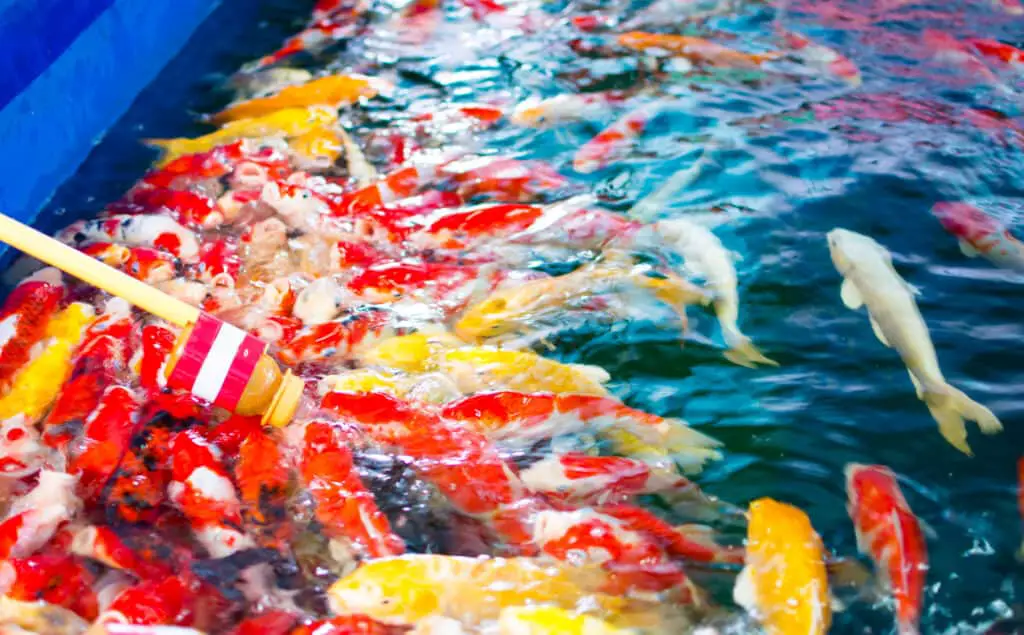
With the knowledge, you have gained about the kind of foods that Koi eat in the wild, their nutritional requirements, and the best foods for Koi, you probably have a good idea of what ingredients to put into your homemade koi food. But what sort of proportions should you use? Find out some practical recipes for making koi food at home!
A Recipe For High Protein Koi Paste

As Koi are naturally bottom-feeders, food that sinks to the bottom fits with their natural way of feeding. You can make a paste to feed them by blending common foods.
Pastes are also great for smaller fish and fry, which cannot eat larger pellets. They can easily suck up the goopy paste into their mouths.
Just take care not to overfeed your koi fish: because the food is at the bottom, you won’t be able to monitor how much they’re taking in and for how long.
Because this paste is relatively high in animal protein, it is best given as an occasional treat to boost growth or help fish overcome sickness.
To make it, toss the following ingredients into a blender:
- 2 pounds of shrimp
- 2 cups of cooked rice
- 12 canned sardines or an equivalent amount of other oily fish
- Six small cloves of garlic
- 1 cup of orange juice
Blend these ingredients into a well-combined paste. Add 1 to 2 sachets of unflavored gelatin (or agar) and blend until you have a highly nutritious (and smelly) paste.
You can scoop this paste into your koi pond, where it will sink for your Koi to hoover up from the bottom in their natural way.
A Recipe For A Summer Paste
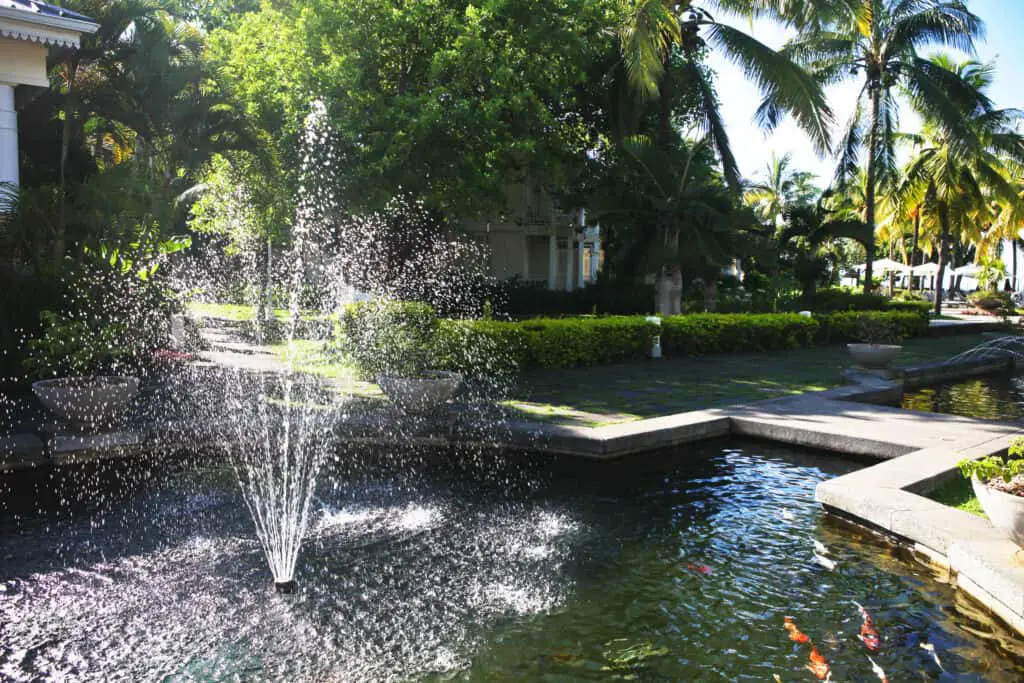
This paste is particularly suited to feeding your koi fish in summer, giving them the boost of protein that your fish need in summer. Because most of the protein comes from peas (vegetable protein), you can feed this paste more consistently than the previous one.
To make this paste, chuck the following ingredients into a blender:
- One medium-sized cooked sweet potato
- 1/2 cup cooked peas
- 1/4 cup krill
- 1/8 cup linseed oil or ground linseed
- 1/2 cup of orange juice, or adjust to alter the consistency of the paste
Combine everything in the blender. Once you have a paste, add 1 to 2 packets of gelatin or agar, and blend to thicken.
Scoop the paste into your koi pond for your fish to feed on, or freeze it for later use. Doing so means you can make bulk food and thaw it as required. You will better know exactly how much to feed your fish with time.
A Recipe For Cooler Weather
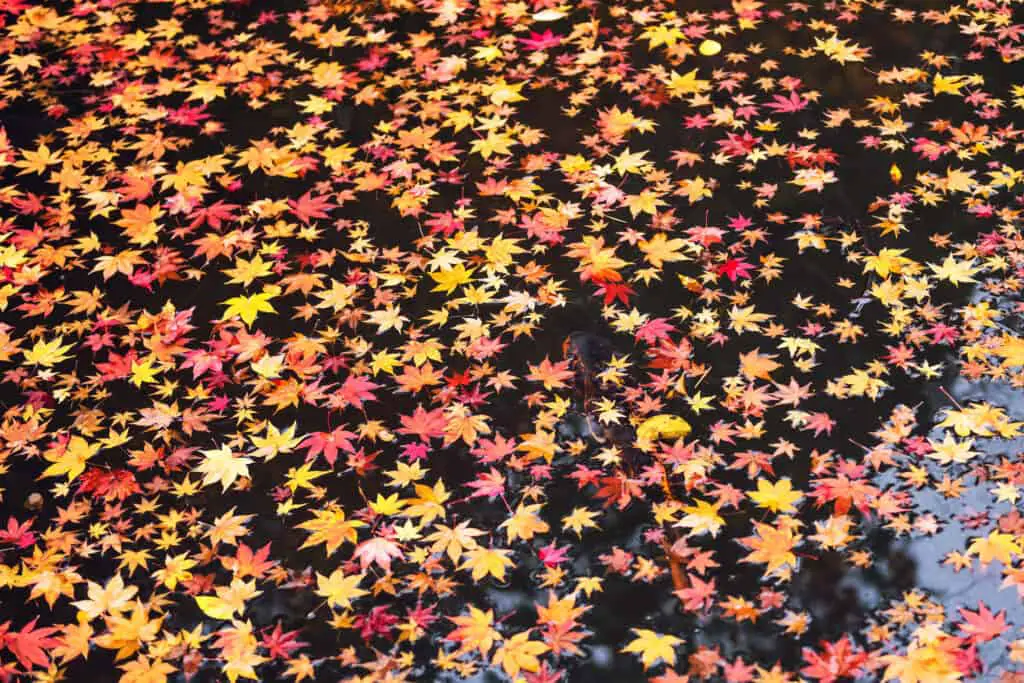
To feed your koi fish properly in cooler weather (provided it is not so cold that they are hibernating), you will need to prepare food with a higher proportion of carbohydrates and a lower proportion of protein.
You can also adapt these pellets for summer use (we will tell you how).
To prepare them, assemble the following ingredients:
1 cup wheat germ
1/4 cup spirulina
1/2 cup cooked spinach or cooked broccoli greens (or a mixture of the two)
1/4 cup carrots
1/4 cup raspberries
1 tsp crushed garlic
Chop up all the vegetables and toss all ingredients into a blender. Blend them until the mixture reaches a dough-like consistency. Form the mixture into small patties (the exact size should depend on the size of your Koi).
Lay the patties on a non-stick baking pan and bake them for 10 minutes at approximately 375 degrees Fahrenheit or until hard.
To modify the pellets for summer feeding, add 1/4 cup krill, shrimp, or blood worms to the ingredients before blending them.
You can refrigerate or freeze the pellets for later use, so this is another suitable option for making bulk batches of koi food.
A Recipe For Color Enhancing Koi Fish Paste


This is the perfect paste for enhancing your koi fish’s color; the carotene in the carrots, sweet potatoes, broccoli, and spirulina powder will make your Koi’s color vibrant. The sweet potatoes will add vitamin B and C, and the broccoli will add calcium and iron to your Koi’s diet.
To make this paste, put these ingredients into a blender:
- One cooked sweet potato
- 1 cup cooked carrots
- 1/4 cup spirulina powder
- 1/4 cup cooked broccoli
- 1/2 cup of water, or adjust to alter the consistency of the paste
Combine everything in the blender. Once you have a paste, add 1 to 2 packets of gelatin or agar, and blend to thicken.
Scoop the paste into your koi pond for your fish to feed on, or freeze it for later use. Doing so means you can make bulk food and thaw it as required.
If you want to learn more about enhancing your Koi fish’s color, I wrote a blog post that you can read here about enhancing koi fish color and why Koi fish’s colors fade.
A Recipe For Color Enhancing Koi Fish Pellets
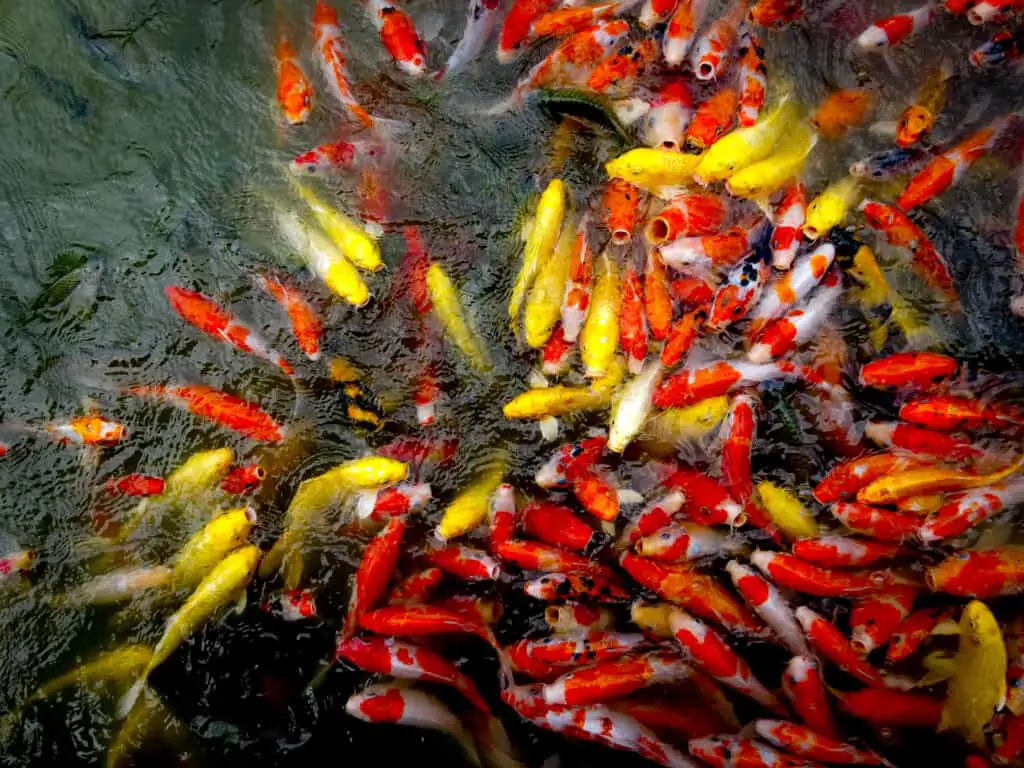
This recipe is also great for enhancing your koi fish’s color, with a dose of spirulina powder and carotene in the form of carrots, spinach, and winter squash. The wheatgerm provides an easily digestible form of protein rich in vitamin B12.
To prepare them, assemble the following ingredients:
- 1 cup carrots
- 1/4 cup spirulina
- 1 cup wheat germ
- 1/4 cup cooked spinach
- 1/2 cup cooked winter squash or butternut squash
Put all ingredients into a blender. Blend them until the mixture reaches a dough-like consistency. Form the mixture into small patties (the exact size should depend on the size of your Koi).
Lay the patties on a non-stick baking pan and bake them for 10 minutes at approximately 375 degrees Fahrenheit or until hard.
You can refrigerate or freeze the pellets for later use, so this is another suitable option for making bulk batches of koi food.
A Recipe For Baby Koi Fish: Egg Yolk Paste
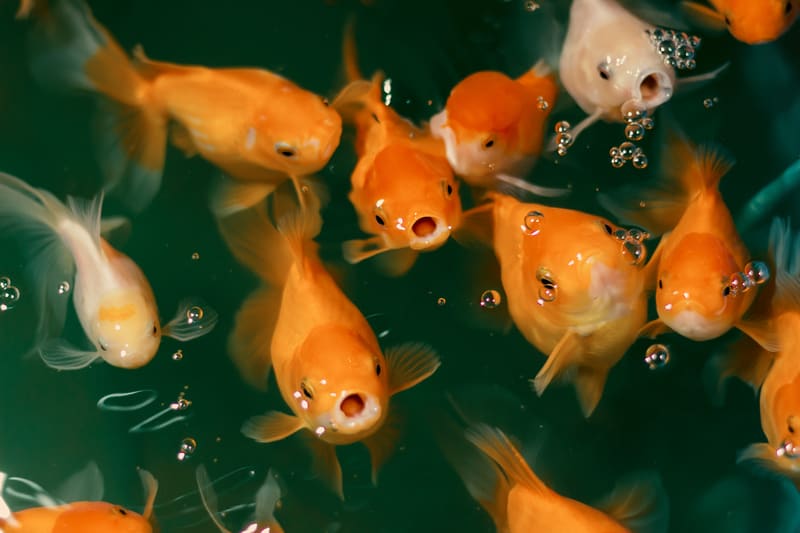
Ingredients
- Purified water
- Three hard-boiled eggs
- A fork
- A sharp knife
- A bowl
- A cup
- A plastic squeezy bottle
Method
When you have collected all the needed tools and ingredients and boiled your eggs, you can now make your egg yolk paste for your baby Koi fish. Follow the steps below to start.
Step 1 – carefully peel the shell off all three hard-boiled eggs.
Step 2 – cut the hard-boiled eggs into halves and carefully scoop out the egg yolks, ensuring you get as much egg white off the yolk as possible.
Step 3 – Place the egg yolks into the bowl and crush them with the fork.
Step 4 – pour one and a half cups of purified water into the crushed egg yolks.
Step 5 – carefully pour the egg yolk mixture into the plastic squeezy bottle.
Step 6 – When you need to feed your baby Koi fish, squeeze a small amount of the egg yolk mixture onto the water’s surface.
When you are feeding your baby Koi fish the egg yolk paste, ensure you feed them little bits at a time, and not more than they can eat within five minutes. The excess egg yolk mixture will then mix with the water in the tank and spoil the water.
This recipe is from my blog post what is the best food for baby koi, in the blog post, I talk about the best foods for baby koi fish, how to feed baby koi fish, how many times a day to feed, how much you should feed them and also what foods you should avoid feeding baby koi fish.
Conclusion
Hopefully, we have given you a good idea of the nutritional requirements of your koi fish and how to provide for them. Using the recipes we have provided, you can give them a balanced, healthy diet every season.
You can also get experimental and try swapping out the ingredients: trying different vegetables, using mushed soybeans instead of wheat germ, or changing up shrimp for blood worms. With the controversies over commercial pellets, why not try making your own homemade koi food?
References
https://premierpond.com/feed-koi-fish-2/
https://pondinformer.com/what-do-pond-fish-eat-guide/
https://pondinformer.com/homemade-koi-food-guide/
https://totallykoi.com/homemade-koi-fish-food/
https://totallykoi.com/what-are-some-koi-fish-food-homemade-recipes/
https://premierpond.com/feed-koi-fish-2/https://pondinformer.com/koi-feeding-guide/
